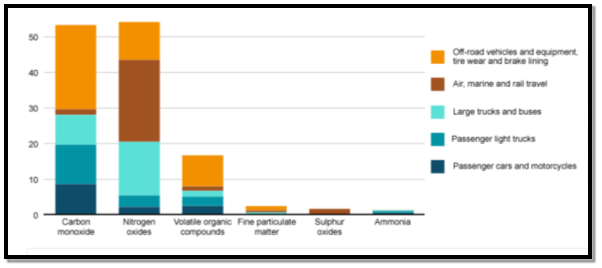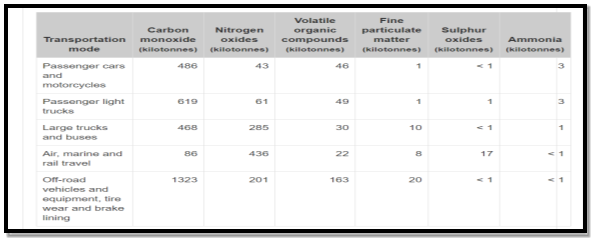Air Pollution Through Transportation in Kootenay
Abstract
This report has focused on Kootenay that is a region in Southeastern British Columbia. In Kootenay, air pollution is getting higher due to transportation systems along with off-road vehicles and mobile equipment. The situation recently got worse when the emissions from transportation systems combined with wildlife fire created a fog in the area that is not only reducing the area of view but also is threatening the health of the residents of Kootenay. This report will mainly highlight how different transportation systems and off-road vehicles are causing air pollution in Kootenay.
Table of Contents
Issue of air pollution through transportation in Kootenay region
Figure 1: Air Pollution through transportation in Kootenay
In Canada, still, most of the transportation systems are powered by fossil fuels. As a result, transportation has become the biggest source of air pollution and Green House Gas emissions in Canada and British Columbia. Transportation systems through which regions of British Columbia are having issues of air pollution are aircraft emissions, marine emissions, rail emissions and vehicle emissions (Manohar and Kavuri 2017). The purpose of this report is to shed light on issues of air pollution due to transportation in Kootenay that is a region in Southeastern British Columbia and the name Kootenay came from Kootenay River. Kootenay region is also known as Kutenai, Ktunaxa where mostly indigenous people of the United States and Canada are living.
 The issue of air pollution through transportation in the Kootenay region
The issue of air pollution through transportation in the Kootenay region(Source: Lavigne et al. 2018)
Transportation along with off-road vehicles and mobile equipment are causing some major amount of air pollution in Kootenay. The burning of fossil fuels for the purpose of running vehicles and engines are causing emissions of many air pollutants. Due to the air pollution in Kootenay formation of Ozone, smog and development of fine particular matter are seen (Pinault et al. 2017).
As per the reports published in 2015, transportation combined with off-road vehicles and mobile equipment is causing more than half of total country’s emissions of Carbon Monoxide and Nitrogen Oxides in Kootenay (Lavigne et al. 2017). On the other hand, transportation in Kootenay is also responsible for 37% total emissions of VOCs that are Volatile Organic Compounds (Lavigne et al. 2018). The images below will describe the situation in a proper manner.
The image below will highlight the emissions of air pollutants from transportation systems along with off-road vehicles and mobile equipment in Kootenay.

(Source: Wang et al. 2015)
In terms of transportation, in Kootenay, large trucks and buses along with rail and marines are highly depended on diesel fuel (Wang et al. 2015). On the other hand, aviation in the region entirely depends on aviation turbo fuel. These sources are considered as the largest source of Nitrogen Oxide. Due to the transportation in the region, it is estimated that a total of 721 kilotons of Nitrogen Oxide is being released in the environment of Kootenay (To et al. 2016). On the other hand, there are also passenger vehicles and trucks. These sources are also causing some serious pollution in Kootenay (Stieb et al. 2015). It is estimated that in urban areas of Kootenay passenger vehicles and the trucks (both big and small trucks) released 1105 kilotons of Carbon Dioxide, 96 kilotons of VOCs and 5 kilotons of NH3 in the atmosphere of Kootenay. Now, it is already mentioned that Kootenay is responsible for 37% air pollution in British Columbia (Lavign et al. 2016). Now, it is also true that air pollution in Kootenay that is caused by off-road vehicles is also responsible for 31% air pollution in the entire region of British Columbia (Erickson et al. 2016). Now, air pollution or emission of air pollutants through marine vessels was also high in Kootenay. However, in previous some years emission of SOx from marine vessels reduced by 90% in Kootenay due to the introduction of more strict regulations and policies.
The condition has worsened recently when Environment Canada and the British Columbia Ministry of Environment recently released a Special Air Quality Statement in effect for East Kootenay. It is stated that this statement issued mainly due to the impact of wildfire smoke. It is also mentioned that due to wildfire smoke the condition in East Kootenay has worsened quit quickly and is varying every hour (Cobb 2019). This statement has also mentioned that people Kootenay can face several bad symptoms that include but are not limited to the problem in breathing, pain in the chest, sudden onset of cough, irritation in throat and headache. It is requested that if any person in Kootenay experience such symptoms then that person should immediately contact with regional health care providers (Cobb 2019). As per the Health Care providers in the regions, people with problems such as Asthma and COPD will face more problems as these people are highly sensitive to air pollution. Now, this serious condition in Kootenay is not only due to wildlife fire (Cobb 2019). It is already mentioned above that due to transportation the condition of air pollution is extremely poor in Kootenay. With this poor condition, the wildlife fire has created to the current extreme condition in Kootenay (Cobb 2019). The condition has become so poor that people of Kootenay are even suggested staying indoor normally and if they are having any health problems such as breathing problem (Cobb 2019). It is also suggested that people of Kootenay must use air conditioners that not only cools the air but also filters the air.
In this condition, the concern of the government and any environment association must be on reducing the air pollution in the area through transportation. The amount of visibility in Kootenay is extremely low and the chances of an outbreak of health diseases for this condition can increase drastically. This poor condition is taking place not only due to the reason of wildlife fire. The air of the Kootenay is already polluted highly due to emission from transportation systems. Now, when the smoke from wildlife fire was mixed with the air in Kootenay, the condition worsened.
In this report, detailed information is provided about the current air pollution in Kootenay. In Kootenay, the air pollution is extremely high and it can be stated that the in Kootenay air pollution is almost highest in all over Canada. Canada is a country where federal and state governments are taking several steps to reduce environmental pollution such as focusing highly on renewable energy sources. In such a nation it is quite unexpected that Kootenay is facing so much trouble due to air pollution. It is also found that recently when Environment Canada and the British Columbia Ministry of Environment recently released a Special Air Quality Statement in effect for East Kootenay. This condition has happened mainly due to this air pollution through transportation systems in Kootenay, not because of wildlife fire created smoke. Therefore, in Kootenay, it is the high time for the federal and state government to take the required steps to deal with this problem.
You have to be 100% sure of the quality of your product to give a money-back guarantee. This describes us perfectly. Make sure that this guarantee is totally transparent.
Read moreEach paper is composed from scratch, according to your instructions. It is then checked by our plagiarism-detection software. There is no gap where plagiarism could squeeze in.
Read moreThanks to our free revisions, there is no way for you to be unsatisfied. We will work on your paper until you are completely happy with the result.
Read moreYour email is safe, as we store it according to international data protection rules. Your bank details are secure, as we use only reliable payment systems.
Read moreBy sending us your money, you buy the service we provide. Check out our terms and conditions if you prefer business talks to be laid out in official language.
Read more